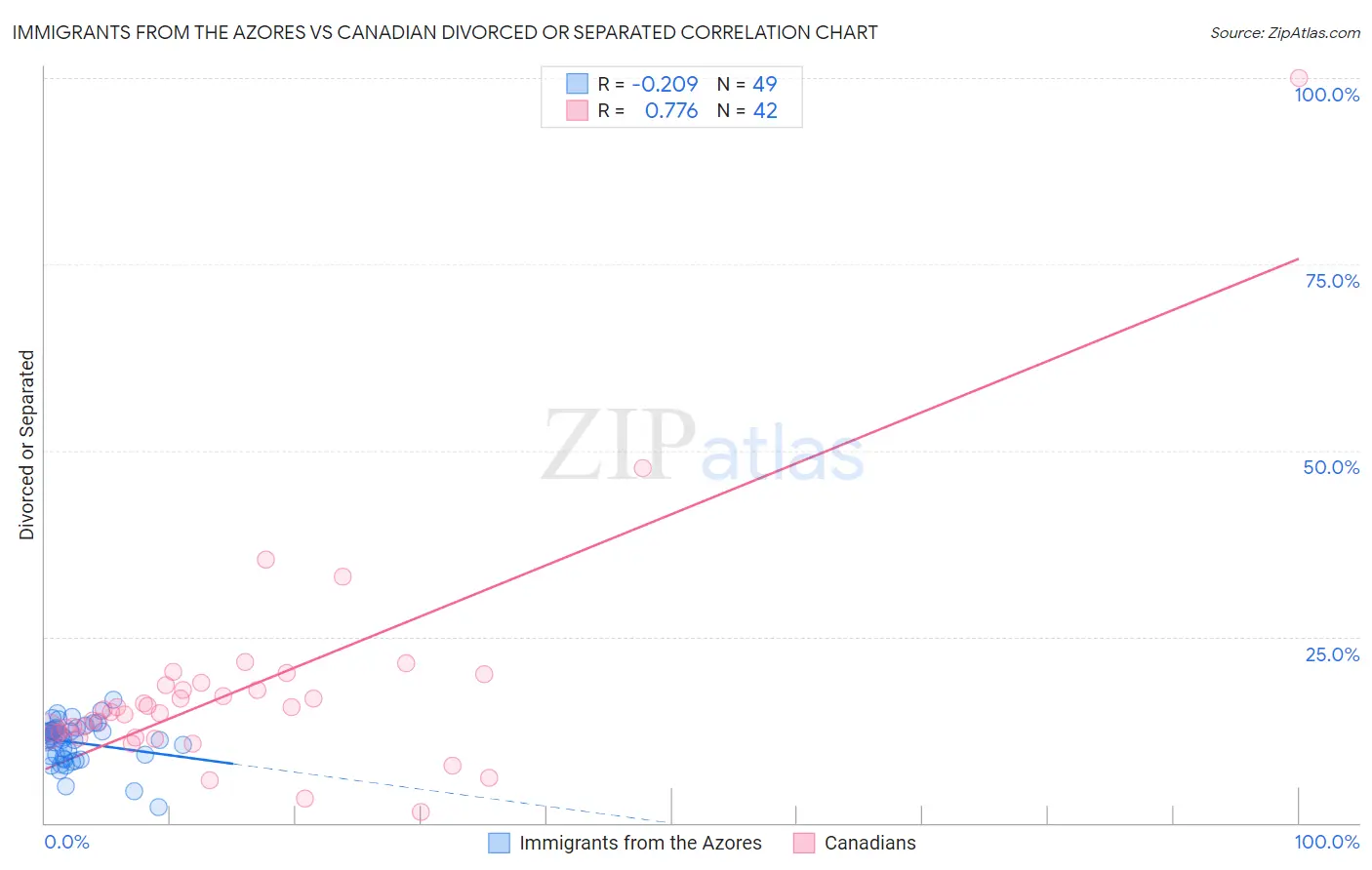Immigrants from the Azores vs Canadian Divorced or Separated
COMPARE
Immigrants from the Azores
Canadian
Divorced or Separated
Divorced or Separated Comparison
Immigrants from the Azores
Canadians
12.3%
DIVORCED OR SEPARATED
9.7/ 100
METRIC RATING
224th/ 347
METRIC RANK
12.4%
DIVORCED OR SEPARATED
5.3/ 100
METRIC RATING
232nd/ 347
METRIC RANK
Immigrants from the Azores vs Canadian Divorced or Separated Correlation Chart
The statistical analysis conducted on geographies consisting of 46,257,310 people shows a weak negative correlation between the proportion of Immigrants from the Azores and percentage of population currently divorced or separated in the United States with a correlation coefficient (R) of -0.209 and weighted average of 12.3%. Similarly, the statistical analysis conducted on geographies consisting of 437,381,276 people shows a strong positive correlation between the proportion of Canadians and percentage of population currently divorced or separated in the United States with a correlation coefficient (R) of 0.776 and weighted average of 12.4%, a difference of 0.55%.

Divorced or Separated Correlation Summary
| Measurement | Immigrants from the Azores | Canadian |
| Minimum | 2.1% | 1.4% |
| Maximum | 16.5% | 100.0% |
| Range | 14.4% | 98.6% |
| Mean | 10.8% | 17.8% |
| Median | 11.4% | 15.1% |
| Interquartile 25% (IQ1) | 8.9% | 12.1% |
| Interquartile 75% (IQ3) | 12.5% | 18.4% |
| Interquartile Range (IQR) | 3.6% | 6.3% |
| Standard Deviation (Sample) | 2.8% | 15.3% |
| Standard Deviation (Population) | 2.8% | 15.1% |
Demographics Similar to Immigrants from the Azores and Canadians by Divorced or Separated
In terms of divorced or separated, the demographic groups most similar to Immigrants from the Azores are Belgian (12.3%, a difference of 0.0%), Immigrants from Western Africa (12.3%, a difference of 0.040%), Bangladeshi (12.3%, a difference of 0.070%), Scandinavian (12.3%, a difference of 0.070%), and Hmong (12.3%, a difference of 0.090%). Similarly, the demographic groups most similar to Canadians are Malaysian (12.4%, a difference of 0.090%), West Indian (12.4%, a difference of 0.17%), Yugoslavian (12.3%, a difference of 0.19%), Immigrants from Bosnia and Herzegovina (12.4%, a difference of 0.19%), and Colombian (12.4%, a difference of 0.21%).
| Demographics | Rating | Rank | Divorced or Separated |
| Slovenes | 13.2 /100 | #218 | Poor 12.3% |
| Czechoslovakians | 11.7 /100 | #219 | Poor 12.3% |
| British | 11.6 /100 | #220 | Poor 12.3% |
| Guamanians/Chamorros | 11.3 /100 | #221 | Poor 12.3% |
| Bangladeshis | 10.5 /100 | #222 | Poor 12.3% |
| Scandinavians | 10.4 /100 | #223 | Poor 12.3% |
| Immigrants | Azores | 9.7 /100 | #224 | Tragic 12.3% |
| Belgians | 9.7 /100 | #225 | Tragic 12.3% |
| Immigrants | Western Africa | 9.3 /100 | #226 | Tragic 12.3% |
| Hmong | 8.8 /100 | #227 | Tragic 12.3% |
| Immigrants | Cameroon | 8.3 /100 | #228 | Tragic 12.3% |
| Immigrants | Sudan | 8.2 /100 | #229 | Tragic 12.3% |
| Yakama | 7.8 /100 | #230 | Tragic 12.3% |
| Yugoslavians | 6.6 /100 | #231 | Tragic 12.3% |
| Canadians | 5.3 /100 | #232 | Tragic 12.4% |
| Malaysians | 4.8 /100 | #233 | Tragic 12.4% |
| West Indians | 4.4 /100 | #234 | Tragic 12.4% |
| Immigrants | Bosnia and Herzegovina | 4.3 /100 | #235 | Tragic 12.4% |
| Colombians | 4.2 /100 | #236 | Tragic 12.4% |
| Immigrants | Laos | 4.2 /100 | #237 | Tragic 12.4% |
| Sudanese | 4.0 /100 | #238 | Tragic 12.4% |